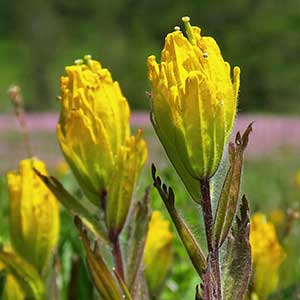Castilleja levisecta
Castilleja rubicundula
golden Indian paintbrush, golden paintbrush
cream sacs
few to many, erect, ± decumbent or creeping at base, unbranched, sometimes branched, hairs spreading, medium length and long, soft, mixed with short stipitate-glandular ones.
solitary, erect, unbranched, sometimes branched, hairs spreading, short, soft, often mixed with stipitate-glandular ones.
green to purple or brown-tinged, linear-lanceolate proximally, oblong-ovate or -obovate distally, 0.8–5.2 cm, not fleshy, margins plane, distalmost sometimes ± wavy, involute, 3–7(–11)-lobed, apex obtuse;
lobes erect to ascending, linear to linear-spatulate, very short, toothlike, usually arising from distal 1/3 of blade, apex rounded.
green to purple-tinged or dark red-brown, linear-lanceolate or distal lanceolate, 2–8(–9) cm, not fleshy, margins plane, flat to slightly curved up, 0–7-lobed, apex acute to acuminate;
lobes widely spreading or ascending-spreading, linear, apex acute.
2.5–25 × 1–4 cm;
bracts bright yellow throughout, or proximally greenish, distally bright yellow, sometimes deep yellow-orange, especially with age, oblong, elliptic, or obtuse to ovate, (0–)5–9(–13)-lobed, sometimes wavy-margined;
lobes erect to ascending, oblong, short to medium length, arising above mid length, central lobe apex rounded, lateral ones rounded to acute.
2.5–24 × 3–4 cm;
bracts green throughout, lanceolate to ovate, 5–9-lobed;
lobes ascending, linear-lanceolate or lanceolate, medium length, arising near mid length, apex acute to acuminate.
straight or slightly curved, 17–28 mm;
tube 12–15 mm;
beak exserted, adaxially green or greenish yellow, 6–8 mm;
abaxial lip yellow or greenish, reduced, not inflated, 2–3 mm, 25–33(–50)% as long as beak;
teeth ascending to erect, yellow, 0.5–1.5 mm.
straight, (15–)20–28 mm;
tube 8–24 mm;
abaxial lip, beak, and proximal part of corolla tube exserted;
beak adaxially white, rarely very pale yellow or pale pink-purple, 5–7 mm, inconspicuously puberulent;
abaxial lip white, fading to pink to pink-purple, or yellow, fading to white, rarely then to pink or pink-purple, both forms often with purple or red dots at base, inflated, prominent, pouches 3, 8–10 mm wide, 4–6 mm deep, 4–6 mm, 80–100% as long as beak;
teeth erect, white or yellow, 0.5 mm.
distally yellow, 13–22 mm;
abaxial and adaxial clefts 4–9.5 mm, 30–40% of calyx length, deeper than laterals, lateral 2.5–4.5 mm, ca. 25% of calyx length;
lobes linear to narrowly oblong or narrowly lanceolate, apex obtuse, sometimes rounded to acute.
green, 8–14 mm;
abaxial and adaxial clefts 3–6 mm, 30–50% of calyx length, all 4 clefts subequal;
lobes linear, apex acuminate to acute.
± exserted, as long as or slightly longer than beak and visible from abaxial side.
= 24.
= 24.
Castilleja levisecta
Castilleja rubicundula
Castilleja levisecta is listed as threatened in the United States and endangered in Canada, where it is extremely rare. Most of its grassland habitat has been altered by development in the Puget Trough, and there are historical stations in the metro areas of what are now Victoria, Portland, and Seattle. For several decades, C. levisecta was considered extirpated from Oregon. However, recent reintroduction programs in Oregon and Washington have been very successful at reestablishing this species at several sites in the Willamette Valley. The bright yellow inflorescences often gradually age to a golden yellow color, unique in the genus.
Castilleja levisecta is in the Center for Plant Conservation’s National Collection of Endangered Plants.
(Discussion copyrighted by Flora of North America; reprinted with permission.)
Varieties 2 (2 in the flora).
Castilleja rubicundula is separated into two varieties on the basis of flower color, as well as subtle differences in the pouching of the abaxial corolla lip. The ranges of the two varieties are broadly overlapping, but they never grow in the same location. Few intermediate forms have been recorded, though a very unusual population system exists in Santa Clara County, within which virtually all plants exhibit a tricolored corolla sequence, with yellow flowers aging to white and then pink or pink-purple, with all three colors visible on mature inflorescences.
(Discussion copyrighted by Flora of North America; reprinted with permission.)
1. Abaxial lips of corollas white, in most populations quickly fading to pink or pink-purple. | var. rubicundula |
1. Abaxial lips of corollas light to bright yellow, in some populations quickly fading to white, then rarely to pink or pink-purple. | var. lithospermoides |


